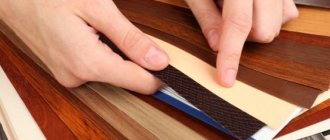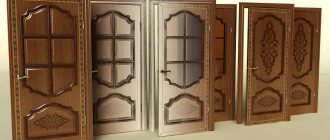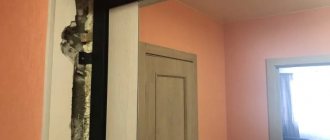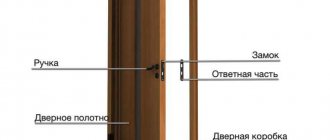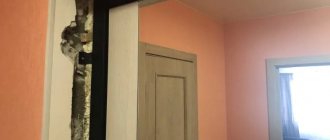“We are greeted by our clothes, we are seen off by our minds” - these words are mainly applicable to people, but if we talk about our home, then such “clothes” can be called the door of the house. It plays an important role: it creates a good impression both of the housing and of the owner himself. In our age of artificial materials, many have forgotten that natural wooden doors have always been in trend and were considered a symbol of reliability. And antique-made things attract people with their sophistication and appearance. So let's look at how to make an antique door with your own hands.
Preparatory work
Before starting work, you should remove the doors from their hinges and place them horizontally on a hard surface. Two stools are suitable for this purpose. Then, using a hair dryer, you need to remove the old paint. How to do this? By heating paint, which will swell under the influence of temperature. Now it can be easily removed with a spatula.
The next step is to seal all the gaps, cracks and potholes formed during operation. To do this, you will need putty, the color of which should be close to the shade of the wood.
Ideally, use a furniture varnish based on beeswax. It is not cheap, however, if you want to make your entrance doors beautiful, reflecting the color and texture of natural wood in its full glory, then you should not skimp on finishing materials.
The final stage is sanding. In order for the paint to lie smoothly in the future, you need to polish it thoroughly. Doing this by hand is difficult and time-consuming, so a grinding machine will help. Now you need to decide how to decorate the door.
other methods
Paneled door decorated with carvings
Solid wood of beech, oak, ash and poplar is aged by chemical treatment. The door is thoroughly cleaned with fine-grained sandpaper and ammonia is applied to the entire surface. It reacts with tannins, causing darkening and brightening of the wood structure. For coniferous species, this method is unacceptable, since such wood does not contain tannins.
You can achieve a dark color and a relief structure of the fibers by singeing the door - the canvas is burned with an open fire of a blowtorch. After heat treatment, the surface is polished. The final touch is varnish or stain. Creating a rare door is an interesting and creative process; it gives you a chance to show your artistic taste and individuality. All methods of influencing wood are available at home and do not require expensive compounds and tools.
Brushing
The beauty of this method is that in the end result it will be difficult to determine whether it is a “fake” or a real rare item. Only a professional can understand this.
This technique includes 4 main stages:
- First you need a metal brush. Choose a brush with a stiff wire. With its help, you need to remove and deform the soft layers of wood. After this treatment, the surface will become embossed, and you will give the canvas structure. This should be done carefully, ensuring that the surface and depth of the structure are uniform.
- During work, the surface becomes shaggy and linty. This effect is not needed, so the wood will need to be tidied up. Here the same metal brush comes into play, only with soft wire. It will not pull out new fibers, but will allow you to get rid of old hangnails. Such work is carried out exclusively along the fibers; in no case do it across, as the structure will deteriorate and the wood will look torn.
- To bring the surface to the desired “condition” you need a soft polymer brush. Use it to remove small lint. We do everything as in the first and second stages.
- The last stage is applying a decorative coating. To do this, use wax-containing oil. First, you need to fill the recesses with a dark shade of oil, and cover the entire surface of the canvas with a lighter shade. If desired, you can do the opposite.
It is important to note that not all types of wood are suitable for such manipulations. For example, products made from birch or beech have a poor structure, but oak or pine doors are ideal.
Applying stain
Covered with stain
To create an original color and emphasized wood pattern, water-based stain is used. This composition penetrates the pores of the wood and reacts with tannins. Penetrating deep into the canvas, the stain lifts the wood fibers and makes its structure more prominent. The colors of the stain allow it to be applied to various types of wood, it will highlight light shades, reddish and black. Apply the composition with a foam sponge or brush. The work is carried out in several stages, the first layer being the most abundant. After it dries, you can sand the surface and paint it again. The finished door is waxed.
Patination technology
This method involves using several paints with different shades. The method is not the easiest, so you will need to follow a clear sequence and rules. The work order is as follows:
- Cover with a base coat of paint. It's best to use a spray bottle, but if you don't have one, a brush will do. The main condition is not to leave streaks or drips from the brush. It will be difficult to achieve this, and some will even say that doing it with a brush or roller is simply unrealistic. Although if you want, you can do anything, you just need a little patience. After painting, the doors need to dry. It is recommended to start the next stage in a few days.
- When the surface is ready, apply the next layer of paint with a different shade. In this case, there is no need to use a spray bottle. Need a brush. It is important to apply the paint in a thin layer. You should not immerse the brush deep into the container, as drips are inevitable. The essence of these manipulations is to draw structural stripes.
- Then we wait until the paint begins to dry, but do not let it dry completely. We create abrasions using a dry rag. As a result, the lower, dark base will be visible through the light tone of the paint, which will give the door a shabby look and the feeling that it has been painted more than once, a couple of decades apart. All this needs to be opened with varnish.
Scuffed effect
This method is suitable for both wooden products and MDF doors.
- At the first stage, the surface is covered with a thin layer of paint, as close in shade as possible to the original color. You can also resort to a brighter option - “yellow gold”, for example, if you want to get a more colorful product.
- If there are a lot of protruding parts on the sash, then only certain areas can be painted with bright acrylic paint.
- After drying, apply a second layer - lighter, even milky.
- After drying, abrasions are formed using fine-grain sandpaper. You must act carefully: as soon as the bottom layer is visible through the top, work must be stopped.
Craquelure
The technology for producing deep and small cracks in a painted canvas is called craquelure. Why? Craquelure is a material that creates the effect of breaking an integral layer. Anyone can age entrance or interior doors using this method. If you strictly follow the instructions, the result will be the best.
The first step is to apply the base paint. When the surface is dry, you need to spray the finishing coat (craquelure) onto it. As a result, the components will cause the base layer of paint to become covered with a web in the form of decorative cracks. This will take a few minutes. Oddly enough, but that's all. There shouldn't be any difficulties.
Which paint color to choose is entirely your decision; the shade options are very different. There are no rules or advice here. You can take into account the color of the trim in your home or room.
Of course, there are many more technologies for aging doors: carving, adding metal or wooden overlays, painting and more. But these methods are quite complex. The methods described above will be enough to give your door several decades of life.
Wood aging options
Doors influence the opinion of the house and its owner. Therefore, the owners are concerned about their appearance. Scuffs and scratches are considered constant accompaniments of aging, but there are options for artificial aging:
- Brushing;
- Application of stain;
- Paints;
- Craquelure varnish;
- Patination.
When choosing a technology for how to make a sash old, pay attention to the properties of the canvas and the decor of the room.
Solid artificially aged wood
Photo
Sketches of antique doors
Antique entrance door
Antique doors
Aged solid wood doors
Beautiful aged door
Beautiful antique door
Antique door fittings
Cracked surface effect in contrasting colors
Oak door
Antique doors
Decoupage of doors
Did the article help you?
Preliminary preparation of doors
This process consists of the following components:
First of all, you need to remove the old paint or varnish to the main surface of the wood using a spatula.
- Unscrew hinges, locks, latches and handles (if they are on the doors). This work must be done slowly, otherwise chips may result, which will require additional time to process.
- The entire surface of the door must be cleaned of dirt and dust. This is done with a sponge soaked in soapy water.
- First you need to remove all the old paint or varnish down to the main surface of the wood. To do this, the doors are placed in a horizontal position (for example, placed on two benches) and the old coating is removed using a sanding machine or sandpaper. If the doors are large, the work can take a long time, especially if it is done manually. First you need to use coarse sandpaper, and then gradually switch to fine sandpaper.
- After this, you need to sand the surface of the wooden door itself.
- If there are depressions or cracks (cracks, cracks) on it, then they must be puttied and, after the leveling layer has dried, sanded. For putty, mastics and other similar materials are used, matched to the color of the base layer of wood. The work is carried out using a rubber or plastic spatula.
You can remove the old layer of paint using special solvents, which are applied with a brush.
You can also use more modern materials to remove old paint, such as a special gel or liquid, which can be bought at the construction market or in similar stores. These products are applied to the surface of the door with a roller or brush. If an aerosol chemical is used, it is sprayed over the surface of the wood for several minutes. If the layer of old paint is thick enough, then this procedure is carried out several times. Peeled paint is removed with a spatula.
Some people use a hair dryer or a blowtorch in such cases. But this method cannot be used if the doors have glass inserts. They must first be removed and only then thermal paint removal can be used. It is better for inexperienced people not to resort to such methods, since when using, for example, a blowtorch, scorch marks may remain on the wood, which will negate all the work. In this case, you will need to follow safety regulations.
Often, after removing the old coating, it turns out that the wood of the door has uneven coloring in the form of light and dark areas. To even out the color scheme, you can use special bleaches for wooden structures. They are diluted in a ratio of 1:3 in water and applied to the tree with a roller.
After this treatment, the paint is easily removed from the surface of the door. Then it is sanded with fine sandpaper and the cracks and depressions are filled.
Design
Doors that are unpainted and without other types of finishing can, of course, perform their main function without any problems. And they will be relatively inexpensive. However, such a choice is simply boring and is unlikely to inspire anyone. Therefore, almost everyone prefers completely different ways to design openings in a home or other building. Without a doubt, classic doors remain unrivaled.
They are mainly colored brown, including its various shades. Varying this range and combining it with other interior details allows you to provide the necessary variety. When selecting a specific color, they start from the colors of the main surfaces and the main decorative items of the room. Along with the classics, doors with glass inserted are often used - and they are most appropriate in living rooms, where very large glass inserts can be used.
Preparing the surface
Before starting the main stage of work, it is necessary to carry out preliminary preparation of the door, which will require using a spatula to get rid of old paint or varnish on the doors.
Afterwards, all overhead fittings are removed from the door, but it is better to avoid damaging its surface. Then, if necessary, the resulting burrs and other irregularities are cleaned. In the future, if there are cracks or other depressions and scratches on the surface of the doors, they must be puttied, and then, after waiting for them to dry, sand them.
You can use mastic or similar materials as putty, matching them to the color of the door. For work, a spatula made of non-metallic materials is used. Sometimes, after removing the old door coating, it becomes clear that the doors have an uneven color. A special wood bleach helps correct the situation. As a rule, it is diluted in water in a ratio of 1 to 3 and applied with a roller to the surface of the door. After this, it is necessary to remove all dust and dirt from the surface of the door using soap, a sponge and water.
How to paint doors antique
There are several processing options that can be used to artificially age wood. This can be done in the following ways:
- Heat with a hairdryer. Remove the coating with a spatula.
- By using solutions that remove paint.
When the procedure is completed, it may turn out that the solid wood has an uneven color after removing the paint. To remove the defect, you should take bleach, which is produced for treating wooden surfaces. It is diluted in a ratio of 1:3, and then applied with a soft roller to the surface.
If cracks, scratches or chips are visible on the surface, these places need to be covered with a large amount of putty. It is chosen based on the color of the wood. A light paste is applied to the pine, after which the surface is sanded - and the sash is ready for further processing.
Brushing
An antique entrance door will decorate the interior of the room. It can be done using brushing. This is an affordable way to easily age wooden products at home. It is based on the use of brushes used to treat the surface. In industry, a milling cutter with a set of attachments is used instead. At home, a similar result can be easily achieved using a metal brush with wire bristles.
The structure of wood is heterogeneous, natural fibers have different qualities. Some of them are more resistant to the influence of negative environmental factors, while others quickly suffer from abrasion. The effects of time can be simulated. By running a wire brush over the wooden surface, the craftsman removes soft fibers. The solid ones remain at the base of the canvas.
The brushing procedure consists of the following steps:
- The wooden door is laid on a flat surface. The old layer of paint and varnish is removed from the base, using a hot or chemical method.
- Soft fibers are cleaned with a wire brush or milling machine.
- Use nozzles with softer bristles to remove chips from the surface.
- The wooden surface is polished; this treatment makes the structure more luxurious. When finishing the product, it is necessary to apply wax or varnish.
Doors are often coated with oil and wax, which gives them shine. There are other processing methods; on a light background they create the effect of scuffs and cracks.
Painting with stain
In order to emphasize the texture of the wood, it is treated with stain. The composition penetrates deeply into the pores, and a reaction with tannins begins. As a result of the action of the product, the fibers rise, the structure of the wood becomes more prominent.
It is convenient to apply the stain with a brush or foam sponge. Solid wood is painted several times; the first time the layer is applied, it should be the thickest.
When the product has dried, the door is sanded and painted again. After completion of the work, the surface is rubbed with wax. The stores offer a wide selection of stains, so the buyer will find products for different types of wood.
Patination technology
This technique allows you to create light abrasions on a wooden surface in several stages. First, the array is processed with sandpaper, then you can start painting.
The paint is applied in 2 layers. The first one should dry well. The second layer is applied using brushes with soft bristles, then in some places the not yet dry surface is rubbed with a rag.
Fabric wear
It is recommended to make abrasions using paraffin and paint; they are applied alternately. When the surface is dry, it is treated with a spatula. Then the door is sanded and covered with stain. When the work is completed, the product is waxed.
Craquelure
You can age the doors yourself using craquelure varnish. Before chemical treatment, the array is first coated with paint, then a product is applied to it.
It contains components that cause the base to crack. Applying a decorative coating leads to the formation of cracks.
Mechanical techniques for creating an antique door with your own hands
Mechanical preparation and painting techniques include:
- staining;
- brushing;
- patination;
- crackling.
Treatment with stain or how to paint a door antique
Making a door leaf stained to achieve the effect of an antique product is quite simple. Moreover, expensive varieties are not required; pine is quite suitable.
You need to very carefully apply a water-based stain to all wooden parts of the door block with a brush or sponge, and then use a sponge to collect excess liquid in the places that need to be brightened - near the door handles, along the perimeter of the door leaf, around the glass, or as your own taste and imagination dictates. . After drying, you can stain individual areas once or twice more, then treat the surface with shellac primer and varnish (shellac is a resinous waste product of tropical insects).
To understand what color you will get after treatment with stain, first try to carry out all the stages of painting on a separate board.
Brushing is a method of removing soft fibers mechanically
The relief in this case is the same as with the thermal and chemical method. Only here the surface preparation is first rough and then soft grinding, which is carried out along the fibers, except for knots, burls and curls - these places are treated in a circular motion with a brush and sandpaper.
After the relief of time-aged wood has been revealed, the canvas is coated with several layers of varnish. After the first application, the surface is cleared of individual raised wood fibers by sanding. If desired, you can tint the product with stain before varnishing.
This looks most impressive when processing lumber with different colors of annual rings - oak, ash, walnut, wenge, larch. This method is not used for maple, beech, alder, cherry and many others.
Patering - a two-color technique to paint a door in an antique style
The preparation of the canvas before applying the patina is carried out by brushing, after which a layer of white or light primer is applied, dried, protruding wood fibers are removed with sandpaper and one layer of varnish is applied. Next, the entire canvas needs to be painted with a light-colored patina, such as gray. The dried layer of patina is sanded with sandpaper, an abrasive stone or the hard side of a kitchen sponge. The patina will remain in the grooves of the wood.
At the second stage, a patina of a second color is applied - dark walnut or dark brown, and the edges are highlighted with a denser layer. After drying, the same tools are used to remove the patina in places, while achieving a smooth transition between colors. The resulting wood pattern is fixed with varnish, applying it in two layers with intermediate drying.
Craqueluering
Craquelure is a specific method of aging a door block, in which it must first be painted with a light shade of paint, and after drying, opened with craquelure varnish. When dried, the resulting film decreases significantly in volume, and the product becomes covered with a network of cracks.
Now you know how to make an antique door with your own hands and everyone will be able to choose the method that suits the interior of their home.
Comments



